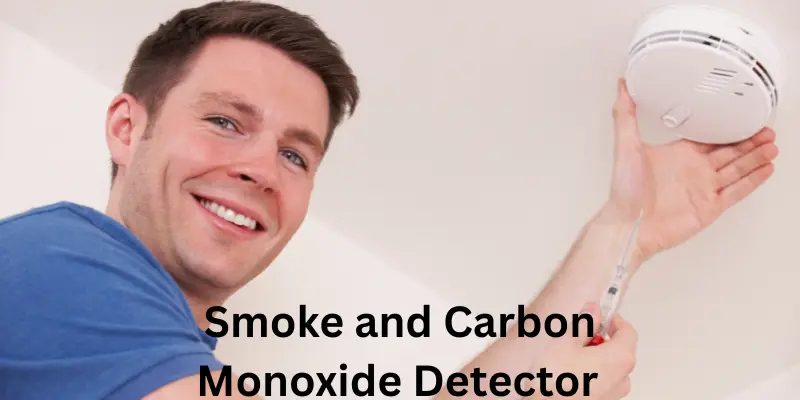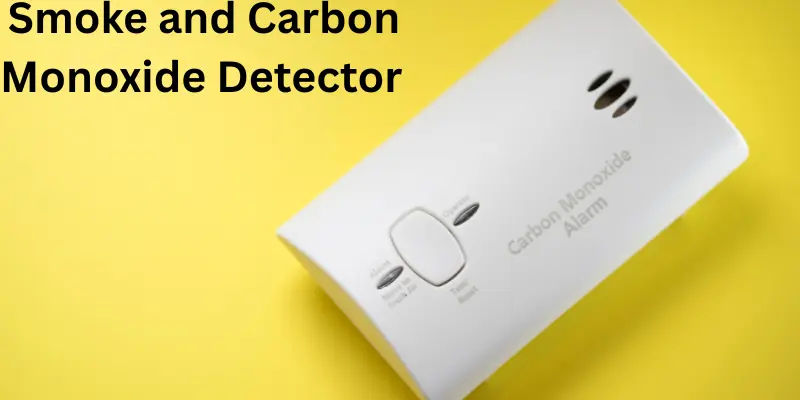Smoke and Carbon Monoxide Detector: Ultimate Guide to Safety, Installation & Maintenance
Updated: 13-Jun-2025
230
A smoke and carbon monoxide detector is one among the safeties. Home safety is more important than ever, and one of the most critical tool in protecting your family. These life-saving detectors play a crucial role in preventing injury or death from two of the most dangerous home threats: fire and carbon monoxide (CO) poisoning.
Fires can spread in seconds, and CO is a silent killer — it’s colorless, odorless, and tasteless. Without proper fire safety alarms, occupants may not be aware of these dangers until it’s too late. Statistics reveal that homes without functional smoke and CO detectors are significantly more likely to experience fatal outcomes during emergencies.

This is where dual smoke and carbon monoxide detectors come in. These devices combine the power of two sensors in one compact unit, offering 24/7 protection against both fire and toxic gas. By promptly detecting smoke or CO in the air, they provide early warnings, giving families precious time to evacuate safely and avoid disaster. Investing in a dual-function detector isn’t just a good idea—it’s a vital part of a comprehensive home safety plan that could mean the difference between life and death.
What Is a Smoke and Carbon Monoxide Detector?
A smoke and carbon monoxide detector is a safety device designed to identify the presence of smoke particles and carbon monoxide (CO) gas in the air. These life-saving devices alert occupants with an audible alarm, providing critical seconds to evacuate or respond to a potential threat. Whether installed in homes, schools, or businesses, a reliable CO detector or smoke alarm system is essential for modern safety compliance and peace of mind.
There are two main types of detectors: single-purpose alarms, which detect only smoke or only carbon monoxide, and dual sensor alarms, also known as combo detectors, which integrate both functions into one unit. A dual-function detector is more space-efficient, cost-effective, and provides broader protection than using two separate devices.
History and Evolution Smoke and Carbon Monoxide Detector
The development of fire and gas detection systems has a fascinating and life-saving journey.
- 1890s: Early fire detectors were manually operated bells or whistles.
- 1930s: The first electric smoke detectors were invented.
- 1965: Duane D. Pearsall developed the first battery-powered home smoke detector.
- 1970s: Widespread home use of ionization smoke detectors begins.
- 1990s: Carbon monoxide detectors became more common after awareness of CO dangers grew.
- 2000s: Introduction of dual-function detectors and smart detection systems.
Through the evolution of smoke detectors, safety standards have continuously improved, offering more accuracy, faster alerts, and smarter integration into homes and buildings.
How Does Smoke and Carbon Monoxide Detector Work?
Modern detectors rely on advanced sensing technologies:
Smoke Detection Technology
- Ionization Sensors: These detect fast-flaming fires by using a small amount of radioactive material to ionize air; smoke disrupts this current, triggering the alarm.
- Photoelectric Sensors: These are more effective at detecting slow-smoldering fires by sensing scattered light from smoke particles.
Carbon Monoxide Sensor
- Electrochemical Sensors: These detect CO gas by using electrodes in a chemical solution. When CO is present, it triggers a change in electrical current, activating the alarm.
These mechanisms are combined in modern units, allowing a dual-function alarm to cover a wide range of emergencies.
Types of Smoke and Carbon Monoxide Detector
Here are the common types available on the market:
| Type | Description |
|---|---|
| Ionization Smoke Alarms | Best for detecting fast-flaming fires. |
| Photoelectric Smoke Alarms | Ideal for slow-smoldering fires. |
| Electrochemical CO Detectors | Most reliable and commonly used for CO detection. |
| Smart Smoke Alarms | Wi-Fi-enabled, smartphone alerts, voice notifications. |
| Basic Models | Simple battery-powered units with basic alarms. |
| Hardwired Units | Connected directly to home power, often with battery backup. |
| Battery-Operated CO Detectors | Portable and easy to install anywhere. |
| Interconnected Smoke Alarms | All units sound together when one is triggered, enhancing alert reach. |
Choosing the right combination ensures optimal protection based on your environment.
Comparison Table Smoke and Carbon Monoxide Detector
| Feature | Smoke Detector | CO Detector | Combo Detector |
|---|---|---|---|
| Detects fire | ✅ | ❌ | ✅ |
| Detects gas (CO) | ❌ | ✅ | ✅ |
| Power source | Battery/Hardwired | Battery | Both |
| Installation | Wall/Ceiling | Wall | Dual placement |
This comparison highlights the benefits of investing in a combo detector for all-around safety.
Uses of Smoke and Carbon Monoxide Detector
- Residential Safety – Protecting homes from unseen fire and CO threats.
- Commercial Buildings – Meeting building codes and ensuring staff safety.
- Hotels and Resorts – Protecting guests and reducing liability.
- Schools and Colleges – Essential for safeguarding students and staff.
- Hospitals – Life-saving alerts in sensitive healthcare settings.
- Underground Garages – Preventing CO poisoning in enclosed vehicle areas.
- Rental Apartments – Ensuring tenant safety and compliance with legal standards.
- Public Buildings – Municipal safety and risk mitigation.
- Mobile Homes – Where compact dual detectors are essential.
- Industrial Zones – Monitoring hazardous environments for smoke and toxic gases.
Installation Guide of Smoke and Carbon Monoxide Detector
Correct placement of detectors is vital for early warning:
Where to Place Detectors:
- Bedrooms: One in or near each sleeping area.
- Hallways: Central locations between multiple rooms.
- Kitchens: Not too close to cooking appliances to avoid false alarms.
- Garages: Especially important for CO detection due to vehicle exhaust.
Mounting Height and Position:
- Install smoke detectors on ceilings or high on walls.
- CO detectors should be placed at head height, where people breathe.
- Combo units should follow manufacturer recommendations.
Power Setup:
- Hardwired Installation: Often required in new buildings. Connects to electrical wiring with battery backup.
- Battery-Powered Models: Easier for DIY installation but need regular battery checks.
Proper smoke detector installation and CO alarm placement drastically improve detection efficiency and safety.
Maintenance and Battery Replacement of Smoke and Carbon Monoxide Detector
Regular maintenance of your smoke and CO detectors is vital for safety and reliability. Here’s how to keep your units functioning properly:
- Test the alarm: At least once a month by pressing the “test” button.
- Battery replacement: Replace standard batteries every 6–12 months, or use 10-year sealed battery models to avoid frequent changes.
- Sensor lifespan: Detectors don’t last forever. Replace units every 7 to 10 years, as per manufacturer guidelines.
- Resetting the alarm: After battery replacement or a false alarm, press and hold the reset button until the unit beeps.
Common Issues and Troubleshooting of Smoke and Carbon Monoxide Detector
Even the best alarms face issues occasionally. Here are common problems and how to fix them:
- Beeping and chirping: Often indicates low battery or sensor expiration.
- False alarms: Caused by steam, cooking smoke, or dust; clean detectors regularly.
- Sensor malfunctions: If persistent, replace the unit.
- Error codes: Refer to your model’s manual or app to interpret codes and alerts.
Tip: Many users confuse detector beeping issues with actual alerts — always check the battery and expiry date first.
Top Brands and Models of Smoke and Carbon Monoxide Detector
If you’re buying a detector, choose from these trusted brands:
- Kidde – Affordable and reliable
- First Alert – Dual-sensor and smart options
- Nest Protect – Smart features with app control
- X-Sense – Innovative, long battery life
- Google Nest – Full smart home integration
- Honeywell – High-end models with industrial features
These are among the best smoke detectors for home and commercial use.
Smart Smoke and Carbon Monoxide Detector
The future of home safety lies in smart detectors:
- WiFi-enabled: Receive alerts on your smartphone
- App notifications: Get notified of battery status, errors, or detected hazards
- Smart home integration: Sync with Alexa, Google Assistant, or Apple Home Kit
Smart smoke alarms like Nest Protect add a digital edge to traditional safety.
Standards, Certifications, and Legal Requirements for Smoke and Carbon Monoxide Detector
To ensure your detector meets safety benchmarks, look for these:
- UL 2034: Certification for carbon monoxide alarms
- UL 217: Certification for smoke alarms
- NFPA (National Fire Protection Association): Provides guidelines on placement and usage
- Local building codes: Some states require interconnected alarms or smart detectors
Stay informed about smoke detector laws and CO alarm regulations in your area.
Cost and Replacement Duration for Smoke and Carbon Monoxide Detector
Knowing what to spend and when to replace is essential:
- Average cost: $20 – $120 depending on features (basic to smart)
- Replace every: 7–10 years, even if the unit still beeps
- Battery replacement: Annually or as needed
Understanding CO alarm cost and smoke detector lifespan helps with budgeting for home safety.
Benefits of Using Smoke and Carbon Monoxide Detector
Why should every home have them?
- Early warning saves lives
- Prevents carbon monoxide poisoning
- Reduces property damage
- Peace of mind for families
These life-saving alarms are essential fire safety tools that detect toxic gas and smoke in time.
Pros and Cons Table of Smoke and Carbon Monoxide Detector
| Pros | Cons |
|---|---|
| Dual protection from fire & CO | Some models are expensive |
| Easy to install and operate | Occasional false alarms |
| Smart features available | Batteries require regular checks |
| Long lifespan (7–10 years) | Must meet legal regulations |
Future of Smoke and CO Detection
The next wave of safety includes:
- AI-powered alarms: Recognize patterns to reduce false alarms
- IoT integrations: Connect with security systems or emergency services
- Predictive alerts: Warn you before thresholds are crossed
These smart detector technologies will define the future of fire safety.
Buying Guide of Smoke and Carbon Monoxide Detector
When choosing a detector, consider:
- Sensor Type: Ionization, photoelectric, or both
- Power Source: Battery or hardwired
- Interconnectivity: Sync multiple alarms to ring together
- Smart Features: WiFi, app control, remote alerts
Best detector for home depends on size, number of floors, and occupancy. Use this fire alarm buying guide to make the right choice.
Frequently Asked Questions (FAQs)
1. What does a smoke and carbon monoxide detector detect?
Smoke (from fires) and carbon monoxide gas.
2. How often should I test my detector?
Monthly, using the test button.
3. Why is my detector beeping?
Low battery, sensor expiry, or a fault.
4. Can one detector cover an entire house?
No, place detectors on each floor and near bedrooms.
5. How long do batteries last?
6 months to 1 year. Replace annually or use long-life batteries.
6. Do I need both a smoke and CO detector?
Yes. Or use a combination detector.
7. Are combination detectors reliable?
Yes, especially if certified by UL and trusted brands.
8. How do I reset my smoke and CO detector?
Hold the reset button for 15–30 seconds until the sound stops.
9. Where should I not place a detector?
Avoid areas with steam, vents, or direct sunlight.
10. Are there detectors with mobile alerts?
Yes, smart models like Nest Protect and First Alert Onelink support them.

Summary
A smoke and carbon monoxide detector is a critical device that can save lives. It offers:
- Early detection of fire and CO threats
- Easy installation and smart options
- Long-term value and peace of mind
From types and placement to maintenance and upgrades, taking the right steps ensures complete protection.
Conclusion
Installing a dual smoke and CO detector system is no longer optional—it’s a must for every household. Whether you live in an apartment or a large home, these life-saving alarms are your first line of defense.
Take action now: Choose the right model, install it correctly, and test it regularly. Your family’s safety depends on it.
Please Write Your Comments